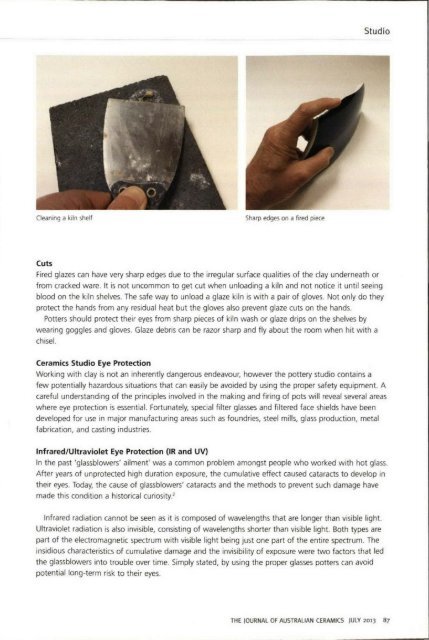The Journal of Australian Ceramics Vol 52 No 2 July 2013
Create successful ePaper yourself
Turn your PDF publications into a flip-book with our unique Google optimized e-Paper software.
Studio<br />
Cleaning a kiln shelf<br />
Sharp edges on a fired piece<br />
Cuts<br />
Fired glazes can have very sharp edges due to the irregular surface qualities <strong>of</strong> the clay underneath or<br />
from cracked ware. It is not uncommon to get cut when unloading a kiln and not notice it until seeing<br />
blood on the kiln shelves. <strong>The</strong> safe way to unload a glaze kiln is with a pair <strong>of</strong> gloves. <strong>No</strong>t only do they<br />
protect the hands from any residual heat but the gloves also prevent glaze cuts on the hands.<br />
Potters should protect their eyes from sharp pieces <strong>of</strong> kiln wash or glaze drips on the shelves by<br />
wearing goggles and gloves. Glaze debris can be razor sharp and fly about the room when hit with a<br />
chisel.<br />
<strong>Ceramics</strong> Studio Eye Protection<br />
Working with clay is not an inherently dangerous endeavour, however the pottery studio contains a<br />
few potentially hazardous situations that can easily be avoided by using the proper safety equipment. A<br />
careful understanding <strong>of</strong> the principles involved in the making and firing <strong>of</strong> pots will reveal several areas<br />
where eye protection is essential. Fortunately, special filter glasses and filtered face shields have been<br />
developed for use in major manufacturing areas such as foundries, steel mills, glass production, metal<br />
fabrication, and casting industries.<br />
Infrared/Ultraviolet Eye Protection (IR and UV)<br />
In the past 'glassblowers' ailment' was a common problem amongst people who worked with hot glass.<br />
After years <strong>of</strong> unprotected high duration exposure, the cumulative effect caused cataracts to develop in<br />
their eyes. Today, the cause <strong>of</strong> glassblowers' cataracts and the methods to prevent such damage have<br />
made this condition a historical curiosity'<br />
Infrared radiation cannot be seen as it is composed <strong>of</strong> wavelengths that are longer than visible light.<br />
Ultraviolet radiation is also invisible, consisting <strong>of</strong> wavelengths shorter than visi ble light. Both types are<br />
part <strong>of</strong> the electromagnetic spectrum with visible light being just one part <strong>of</strong> the entire spectrum. <strong>The</strong><br />
insidious characteristics <strong>of</strong> cumulative damage and the invisibility <strong>of</strong> exposure were two factors that led<br />
the glassblowers into trouble over time. Simply stated, by using the proper glasses potters can avoid<br />
potential long-term risk to their eyes.<br />
THE 10URNAL OF AUSTRALIAN CERAMICS JULY <strong>2013</strong> 87

















